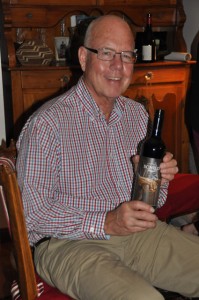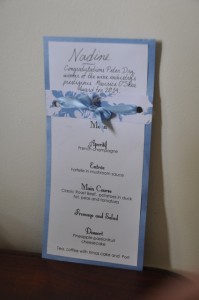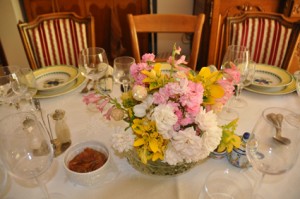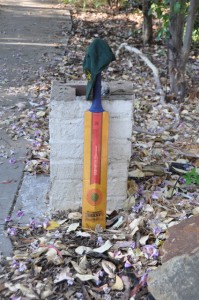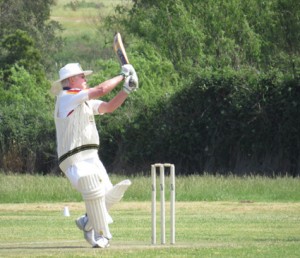Flavoursome food, fine wine – and flowers
It was always going to be a spectacular dinner party. There were eight guests and we had gathered to celebrate the fact that my neighbour and friend Peter Dry, has won the Maurice O’Shea Award 2014 for excellence in the wine industry over his successful 40 year career. Peter and all of the three other male guests were wine connoisseurs. The women in our group loved wine and all guests were gourmands. My friend Jayne was responsible for dessert, so I needed only to prepare entrée and main course, yet the pressure for performing well had me changing menus until the day before.
Here is a photograph of the final menu, which my creative niece Chelsea designed to add a touch of class to L’art de la table. My friends expect a certain Frenchness to shine through and I hope they were not disappointed. As a widow with only those one pair of hands, I had to be organised and I wanted to be relaxed.
I dressed the table the night before our event and was happy with its simplicity and delighted with the central floral display from my own garden.
The evening began with popping the cork of a Moet and Chandon champagne and as a light, summery accompaniment to such a classy French aperitif, I cut up big slices of watermelon into cubes sticking in tooth picks. To provide a contrasting taste, I quartered grapefruit, cutting into sections and drizzling with liquid honey and sticking again with tooth picks. This was a smart move because a friend had given me all of the grapefruit, making it a low-cost, but attractive fruity duo provided a refreshing, unique dish with colour and texture adding interest.
Once we all sat down, I presented the following menu:
Entrée – Farfelle in Mushroom Sauce – I must admit was chosen for its ease preparation, but also because it came from a favourite French cookbook. Voila!
The recipe called for butterfly pasta and Characelle mushrooms, but when they were unavailable, I chose dried porcini, reconstituted, adding fresh, diced and cooked Swiss brown mushrooms. A medley of finely chopped herbs were thrown into the sautéed mushrooms and the swollen porcini, drioed in kitchen paper was added to the mix, but not fried.. Lastly crème fraise was spooned into the hot mixture and I sat back and waited for the accolades.
After much agonising whether to have rolled turkey, I bravely decided on a large 1.8kg Scotch fillet to create the main course – Classic Roast Scotch Fillet. Vegetables were gourmet potatoes, bought in a micro-waveproof plastic bag, peas and baked tomatoes topped with grated cheddar cheese. The butcher said the meat was so delicious it didn’t need to be marinated and simply needed to roats at 180 degrees for 1.5 hours. However at the exciting moment, after allowing the roast to sit for 15 minutes, the first cut clearly revealed a rare piece of meat. What to do? A male guest to the rescue. “Cut it in big slices and stick it back in the overn for 10 minutes,” he said. All it took was another six minutes and the slices were further cut into juicy strips. Another friend helped with the gravy, which was simply juice left after the pan was drained of fat, some of the pea water, a little beef stock and the master touch – A glass of one of the top wines sitting at the bar ready for consumption. What could have been an agonising, undercooked failure, became the piece de resistance of the evening.
My friend’s Pineapple-Passoinfruit Cheesecake was lovely and light and delicious in its biscuit base.
However, such a magnificent meal really was the backdrop to the wines we consumed. Our guest of hnour brought one of his favourite reds, an Accerto Nebbiello d’Alba (even though Peter has been responsible for the education of a few generations of Australia’s current winemakers. Another was Zucolo Fruiti Grave Pinot Grigio, an Italian wine delight in recognition that Peter was largely responsible for the introduction of many French, Italian and Spanish grape varieties to tge vineyards of Australia.
Austtralian wines were not forgotten with a REdman Coonawarra 2008 causing much discussion on which was best – French or Australian reds. French winemakers with vineyards in Australia also featured including Dominique Portet wines of the Yarra Valley because Peter had education Dominique’s son Ben, who is winemaker of the attractive range. His signature wine Ten Men Shiraz 2012 from the Pyranees region was among Schild Estates Shiraz 2008 from the Barossa Valley, Mintaro Clare Valley Riesling 2012 and another 2008, The Islander’s Bark Hut Road, from French winemakrer Jacques Lurton’s vineyard at Pardana on Kangaroo Island.
